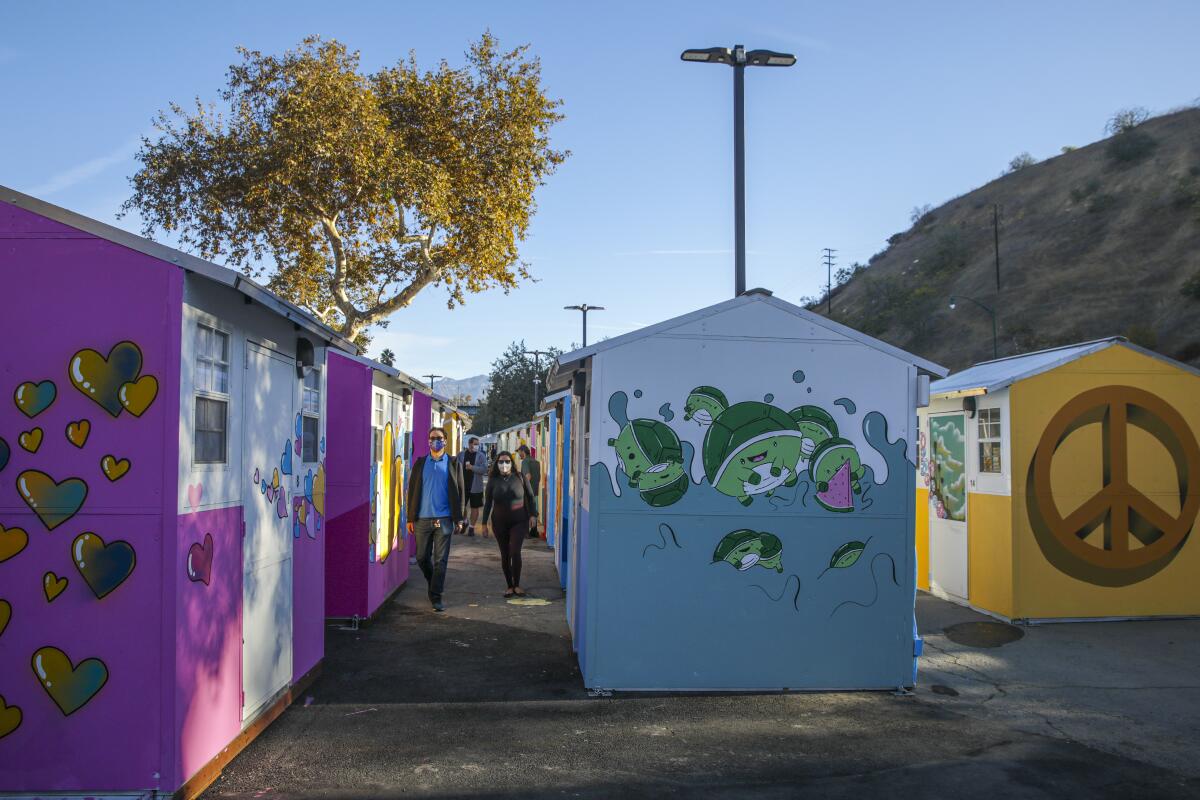Critics of tiny homes wail. But Eagle Rock village is better than tents and offers hope

- Share via
When it was time for my daughter to learn how to drive, I took her to an empty parking lot on Figueroa Street, across from the Eagle Rock Rec Center.
She got the hang of things behind the wheel, but I wondered how that lot could sit vacant for so long, half a block from a homeless encampment under the 134 Freeway. For years, there’s been talk of wasted public space as the homeless population has exploded.
On Wednesday, the parking lot was no more. It’s now a tiny home village, with 93 beds in 48 structures.
L.A. City Councilman Kevin de León, a candidate for mayor, took to the podium at a ribbon-cutting and said the morning’s bright sun represented “a ray of hope and opportunity for our unhoused neighbors.”
As he spoke, a heckler shouted from outside the fence.
“KDL is a liar,” said the protester.
It was no surprise. So-called homeless advocates have disrupted mayoral debates, shutting one down several days ago at a synagogue in Valley Village, and demanding a different strategy.
Who came off the best during Tuesday’s L.A. mayoral debate? Here’s what a few voters had to say.
“This is about his mayoral campaign,” the heckler went on, accusing the councilman of not caring about homeless people. “Tiny tool sheds. These are tiny tool sheds, not real housing. … He doesn’t give out house keys. He gives out handcuffs.”
A De León supporter named Chuck Levin told me that “throughout history, people on the right are criticized by people who are further to the right, and people on the left are criticized by people further to the left. That’s what this is, and the people doing the criticizing haven’t housed one person.”
De León explained that the parking lot was on property owned or managed by the city, the county and Southern California Edison. Prior to his time in office, the parties came together to agree on the housing plan, which is certainly a better use of the property than having it serve as a driver training site.
At a time when permanent supportive housing takes years to build and the average cost per unit has climbed to nearly $600,000, the cost of these tiny homes came to about $68,000 each, or roughly $35,000 per bed, according to De León’s office.
I stepped inside a few of the tiny structures, which get their name honestly. But two beds fit comfortably in the space, there’s a window, a door, and a bank of bathrooms and showers outside.
You do have to shake your head at the thought of producing mini-homes for the destitute in a state of unprecedented public and private wealth, with sprawling mega-mansions selling for more than $100 million apiece.
But for all of that, are these tiny homes better than cardboard boxes and tents?
No doubt.
“It’s not just going to be interim housing,” De León told me. “It’s going to be three meals a day, psychotherapeutic services and drug addiction services.”
In his speeches, De León likes to ask, “in what parallel universe” is it better to leave people on the street than move them into various forms of temporary housing while awaiting more permanent housing?
During the ceremony, I wandered down the street to the homeless encampment. On both sides of Figueroa, tents line the 134 underpass. Over the years, I’ve seen the area cleared out as temporary and sometimes permanent housing are found, but the tents always return before long.
Pedro Cruz, 76, had just stepped out of his small tent on the east side of Figueroa. I asked him if he’d prefer to live in the tiny home village and he said yes. He’s already talked to outreach workers and is on a list to move in the coming days at the official opening.
One man peeked out of his tent to tell me he would definitely not move to a tiny home because “better things are coming my way,” though he didn’t specify what that might be.
Later on, I toured the encampment with Jane Demian, homelessness liaison for the Eagle Rock Neighborhood Council. She’s gotten to know most of the encampment dwellers and said they’ve already been contacted by outreach workers trying to fill the new tiny home village.
As with many other homeless encampments, Demian said, poverty, mental illness and addiction are all factors. When it comes to housing solutions, she said, she deals with critics on the left who want only permanent housing and critics on the right who want the homeless people arrested or moved somewhere else.
“They just want them gone,” Demian said.
“There isn’t enough permanent housing, and we’re fighting for that,” she added, but she thinks a lot of people in the community support temporary and interim housing as better and more humane options than leaving people on the street.
We met up with Dana Blue, a former U.S. Navy reservist and Best Buy employee who said she became homeless after a foreclosure on her mother’s home. Blue, 36, said she plans to move into one of the tiny homes despite reservations.
Get the lowdown on L.A. politics
Sign up for our L.A. City Hall newsletter to get weekly insights, scoops and analysis.
You may occasionally receive promotional content from the Los Angeles Times.
She said she wonders what the rules will be, how the place will be run and whether “it’s another temporary solution to a really big problem that hasn’t been fixed yet.”
But for reasons of safety and hygiene alone, Blue said, she’ll test it out.
“It’s worth a try if it’s getting people off the street,” she said. “I hope to get back on my feet and get out of there. It’s not a perm solution. … Of course, I wouldn’t want to stay in a tiny home the rest of my life.”
Demian pointed out a nearby vigil for a man named Gabriel Estrada, 38, who died in his tent in February, cause unknown.
He was “the fifth unhoused person I know of to die on the streets of Eagle Rock since 2018,” Demian wrote in an obituary for the Boulevard Sentinel. “He had a brilliant smile and a disarming sweetness.”
Estrada, she said, was slated to move into the tiny home village.
More to Read
Sign up for Essential California
The most important California stories and recommendations in your inbox every morning.
You may occasionally receive promotional content from the Los Angeles Times.












